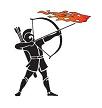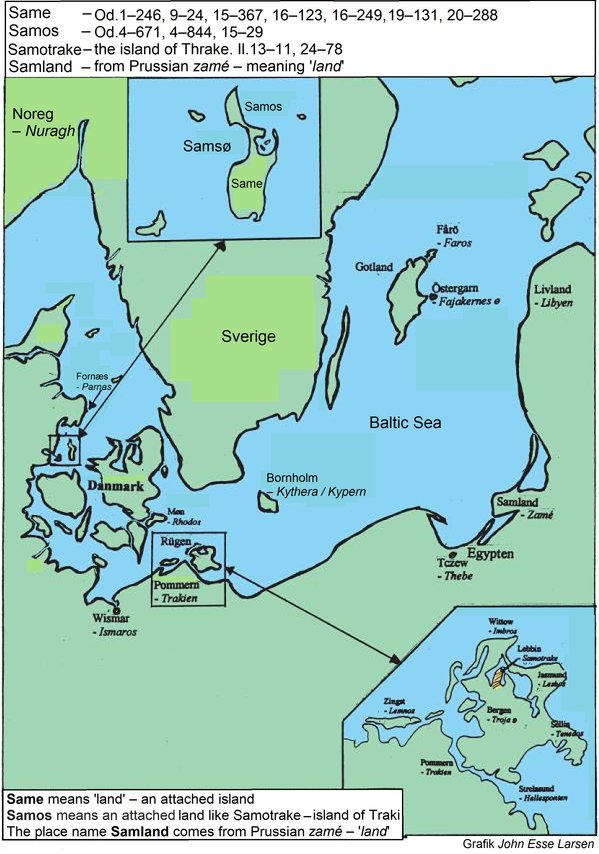
Odysseus
Isse from the island Od in Denmark
Same Samos Samotrake and Samland
Same and Samos – the two-piece island Samsø
.
Today the two islands Same and Samos are linked together with a 300 m wide land bridge. They form the island Samsø north of Little Belt (Danish: Lillebælt) and Great Belt (Danish: Storebælt). Same is the southern island and Samos is the northern island.
The island of Samos in Thraki is called Samotrake. It is the island of Lebbin that today is linked to the main island of Rügen in the south with a broad low isthmus.
Samsø is called Samse by Adam of Bremen and Samsø in the Danish Census Book (Danish: Kong Valdemars Jordebog) from 1231. The great southern island and the smaller northern island have more correct two names Samsa and Sampsø by Saxo, and Samsey and Sámsey in the Icelandic Edda literature.
The two-piece island Samsø is located west of the town Vindekille – Ithaca in the Odyssey. The south island is Same and the northern island is Samos with the 64 meters high Ballebjerg (Balle Hill). In the Stone Age the island Samsø was split into two completely separate islands, the hilly North Island and the slightly flatter South Island.
Land elevations and marine deposits have over the course of several millennia tied the two islands together to form one island – Samsø. Nowadays, they are separated by a silted drag that was dug out as a channel in the 9th century – Kanhavekanal (Kanhave Canal). The canal was used in the Viking age until the 12th century, but exists no longer. It connected Stavns Fjord to the east with the Belt Sea in the west.
The many hills and cliffs on the northern island are often referred to under the collective name Nordby Bakker (Nordby Hills). In the far North lies the protruding 49-meters-high cliff Issehoved (Isse Head).
Samsø covers 114 km2, the southern Same is approximately 94 km2 and the hilly northern island Samos has 20 km2. Today the northern island Samos has about 500 inhabitants, the southern island Same 3800 inhabitants. Same is five times greater than Samos and has seven times as many inhabitants. Samos in the north are not only smaller than the South Island, it is even more thinly populated.
This relationship was likely also so in the Bronze Age.
Same is mentioned seven times in the Odyssey and never because of natural conditions.
– All the best young men who rule the islands,
– Doulichion and wooded Zakynthos, and Same (Od.1-246).
Odysseus tells of the islands which lie close to each other:
– Doulichion, Same, forested Zakynthos. Ithaca itself (Od.9-24).
– They sent her (Ktimene) to Same to be married and got countless wedding gifts (Od.15-367).
– All those lords with power in the islands – Doulichion, Same, wooded Zakynthos –
– and those who rule in rocky Ithaca (Od.16-123, 19-131)
– from Same twenty-four, from Zakynthos twenty young Achaeans (Od.16-249).
– His name was Ktesippos, and he made his home in Same (Od.20-288).
According to the Iliad Odysseus was the leader of the thinly populated northern island Samos. This explains why the suitors and parasites come from Same. They don’t have Odysseus as a their leader and they are even not involved in the war.
Samos is mentioned once in the Iliad because Odysseus is their leader. The island is mentioned three times in the Odyssey and only due to natural conditions.
– He navigates his passage through the strait (Samsø Belt or Samos Belt)
– dividing Ithaca from rugged Samos (Od.4-671).
– Out at sea, half way between Ithaca and rugged Samos (Od.4-844).
– in the straits (Samsø Belt) between Ithaca and rugged Samos (Od.15-29).
The many hills and steep cliffs on Samos are Nordby Bakker (Nordby Hills).
Samotrake – the Thracian Samos
Samos in Thraki is mentioned twice in the Iliad, but it is enough to specify the location of the island.
– High on the tallest crest of wooded Samotrake
– he (Poseidon) sat looking down upon the war going on.
– From that point, Mount Ida was clearly visible,
– Priam’s city, too, and the Achaean ships (Il.13-11).
– Storm-swift Iris (Divine messenger) rushed away, bearing Zeus’ message.
– Half way between Samos and rocky Imbros she plunged into the sea (Il.24-78).
The only place that fits these two descriptions is the former island Lebbin, which is a peninsula today. It is situated between the islands of Imbros and Lesbos – Wittow and Jasmund – behind Jasmunder Nor, which Homer mixes together with the Hellespont.
The highest point on Lebbin is the 43.8-metre-high hill Hoch Hilgor with a 16.5-meter-tall viewing tower, Grümbke-Turm. The tower is named after the local historian Johann Jacob Grümbke who lived from 1771 until 1849.
Today's visitors can stand in the Grümbke-Tower with the Iliad in their hand, and see the same views as the Earthshaker Poseidon could see 3200 years ago. That Poseidon and not Pallas Athene scouts from the Lebbin Hill alludes that the Trojans have control over the island.
It's amazing that the Odyssey and the Iliad can tell both about Fluthäll on Gotland (Od.13-160), of the monster cliff Rockall in the North Atlantic Ocean 350 kilometers west of Scotland (Od.10-515), and of the hilltop Hoch Hilgor on the island Samothrake – that is the Peninsula Lebbin at the island Rügen in the Baltic Sea (Il.13-11).

What does the names Same and Samos mean
.
Same means land and Samos in such a case, the island or peninsula (Danish halfisle).
The name derives probably from the pre-Prussian language Etruscan. In Prussian the words zamé and zemé means just land. The great Russian island in the Arctic Ocean is called Novaya Zemlya – New Land in Russian after Russian Zemlya – land.
On the western side of the Baltic Sea lies the large Swedish island of Öland at the coast of Småland.
Samland in former East Prussia, moreover, is a peninsula, and the name therefore means Öland (Island) or perhaps peninsula (Swedish halfisle).
The inhabitants of Samsø are called Samsings, in German the population in Samland is called samer.
Saxo talks of the people Sember (Saxo 8.10.6, 9.4.23 and 4 more) in Samland.